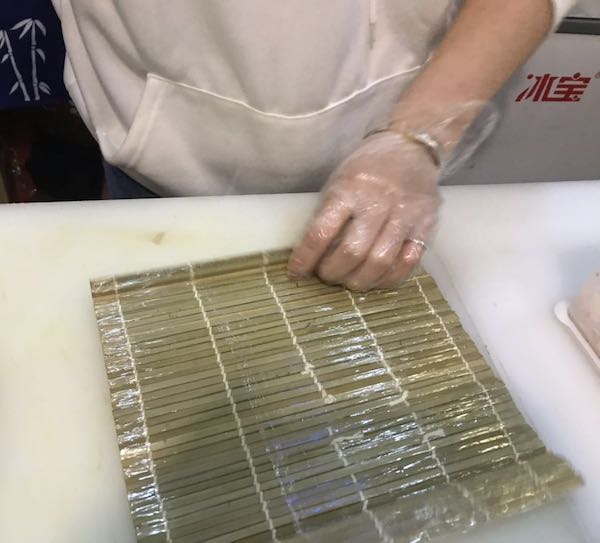We are reader supported. When you purchase through links on our site, we may earn an affiliate commission. Also, as an Amazon affiliate, we earn from qualifying purchases.

I love sushi and it pains me when my favorite roll turns soggy, loses flavor, or turns bland. The two most essential ingredients that constitute the outer texture of sushi are Nori and seasoned rice. However, it is unfortunate that sushi can turn soggy if left out for too long and this can result in loss of flavor.
How to prevent sushi from getting soggy? Nori is probably the first thing that absorbs moisture from rice and turns soggy when kept outside or inside the refrigerator. Prevent this by making only as much sushi you can eat immediately. You can also try some of the tips given below.
Toast the Nori to make it slightly crispier. When you add fillings over the rice, add some dry leafy greens like spinach to ensure that the Nori takes time to absorb moisture from the rice.
Sushi can also become soggy if the rice is overcooked or gooey in texture. Don’t skip soaking the rice and always use rice and water in 1:2 ratio. Read this article to cook perfect sushi rice in a cooker or pot.
Don’t use warm rice for making sushi as the warmth will turn Nori soggy quickly. I recommend fanning the rice with one hand to remove some moisture and cool it completely before using to prepare maki rolls.
Preventing Nori From Turning Soggy Quickly
Love it or loathe it, but you cannot escape Nori when it comes to Japanese delicacies. This edible seaweed has a strong and distinct flavor. It is an essential ingredient not only in sushi but in various other dishes such as onigiri, miso soup, salads, bento and so on.
The longer the sushi roll sits outside after it is made, the soggier the nori becomes. There are different ways to store the Nori inside the refrigerator to save the raw fish and rice from going bad. However, there is no method to keep Nori from losing its texture and flavor.
Nori will turn soggy eventually, and it is inevitable. To prevent this, make sure you prepare sushi rolls only half an hour before you plan to consume them.
You can keep the Nori sheets fresh for longer by toasting them on a gas stove or microwave. For stovetop toasting, hold the Nori sheet using a tong and let it toast slowly.
Alternatively, you may keep the Nori sheet on the baking dish just below the grill for about 30 seconds. Your Nori will turn crispier and less brittle.
Ways To Prevent Sushi Rice From Becoming Soggy
If the rice is too mushy, this can result in the sushi becoming too soft or gooey. You are probably adding a lot of liquids, which is not right.
Always measure water and rice quantities correctly when you want the rice to come out fluffy and nice. Too much water will make it soft, and less water will turn it dry. Always try to cook your sushi rice a bit on the dry side. It will eventually soften in its own warmth.

Don’t skip rinsing the rice to remove the starch. However, be gentle while rinsing so that you don’t break the grains and take care to not rip off all starch from the grains.
When seasoning the rice with the vinegar solution, use a paddle to cool down the rice as you mix vinegar into it. You may use a standing electric fan to cool as you season rice. This step not only prevents sushi rice from turning soggy but also adds shine to the grains.
When the rice is cooked, but it’s too gooey, I suggest uncovering the pot and cooking it on low heat to get rid of the water. You may also put the rice on a baking dish and dry it on the oven at low temperature.
Avoid adding mirin to the sushi rice if you don’t want it to turn soggy. Japan has hot and muggy weather hence they need to add mirin to keep the rice fresh for longer, but you may do without it.
Tips To Restore One-Day Old Sushi
If you have leftover sushi from the other day that you stored in the refrigerator, you probably know by now that it will lose some of its flavors. However, you can still restore some of the texture and taste of your favorite sushi roll with these interesting tips.
Before storing the sushi roll inside the refrigerator, make sure you cover it up in a plastic wrap and then place it inside an airtight container. Now keep inside the refrigerator.
When you take out the sushi from the refrigerator, the Nori will probably be soggy, and the rice will be hard. Microwave the sushi roll for about a minute to bring back the sushi rice to room temperature and make it more eatable.
Trying Different Sushi Varieties Can Help
The maki rolls are most susceptible to getting soggy because they have a full or half Nori sheet on the outside that covers the rice. In the California rolls (inside-out style), the Nori sheet is hidden inside the rice layer but it still turns bland if kept outside for long.

When you know that you will not be consuming the sushi rolls immediately, it better to try a different type of sushi. I would recommend that you make nigirizushi instead of maki rolls. The advantage of making nigirizushi is that it does not have a nori sheet on the outside.
Some nigiri sushi may have a Nori strip but that won’t impact the overall texture or aesthetic value of the sushi. Sushi rice does not get soggy if kept outside unless it’s too hot and humid. The rice can go bad quickly in an extremely humid climate. This is the reason why the Japanese add vinegar to rice.
Another way to enjoy good sushi without worrying about things getting soggy is by making a charishi. This is a great mix of all ingredients used in sushi without requiring to roll them up. You can eat it in a bowl, and it works perfectly for the beginners too.
Temaki sushi rolls are great but if you don’t plan on eating them immediately, you should avoid making these cone-shaped sushi rolls. However, let’s not forget that only a portion of the Nori comes in contact with sushi rice in a temaki roll. As a result, it does not get soggy as quickly as a maki roll.
Simple Hacks To Prevent Sushi From Getting Soggy

Here is a quick trick that anybody who is from Asia may be able to relate to. The hack is to use a thin sheet of plastic between rice and the nori so that moisture does not seep into the seaweed. Before eating, take off the inner layer of plastic to have a less soggy Nori on your sushi.
The only problem with this method is that the inner plastic tends to stick with the rice. Apply some vegetable oil on one side of the plastic sheet to prevent it from sticking.
You can also use baking paper like this instead of Nori if you plan to store the sushi and eat it later. Stack the prepared sushi wrapped in baking paper in airtight containers and keep inside the refrigerator. Just before eating or serving, remove the baking paper, microwave for 30 seconds and wrap a Nori sheet around it. The sushi will taste as good as freshly made ones.
Related Questions
How long can sushi stay fresh?
Sushi made with fresh ingredients can stay good for 24 hours if kept inside the refrigerator. You can prevent it from turning soggy by following the methods mentioned above. Read this article for more information – can you eat sushi the next day.
How to tell if the Nori is good or bad?
The premium quality seaweed is dark green in color, thick and uniform in consistency. Low-quality nori is thin and brittle. They may be cheap, but they tend to get soggy quickly. I would recommend that you purchase only good quality Nori from a reputed brand. Read this article – What is the best Nori for sushi?

